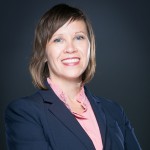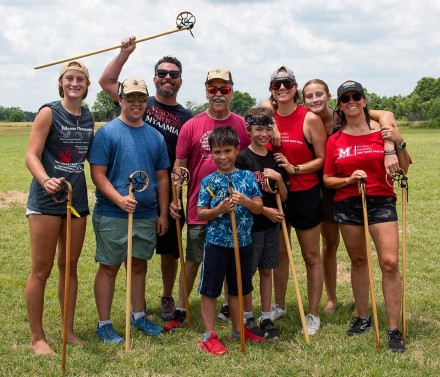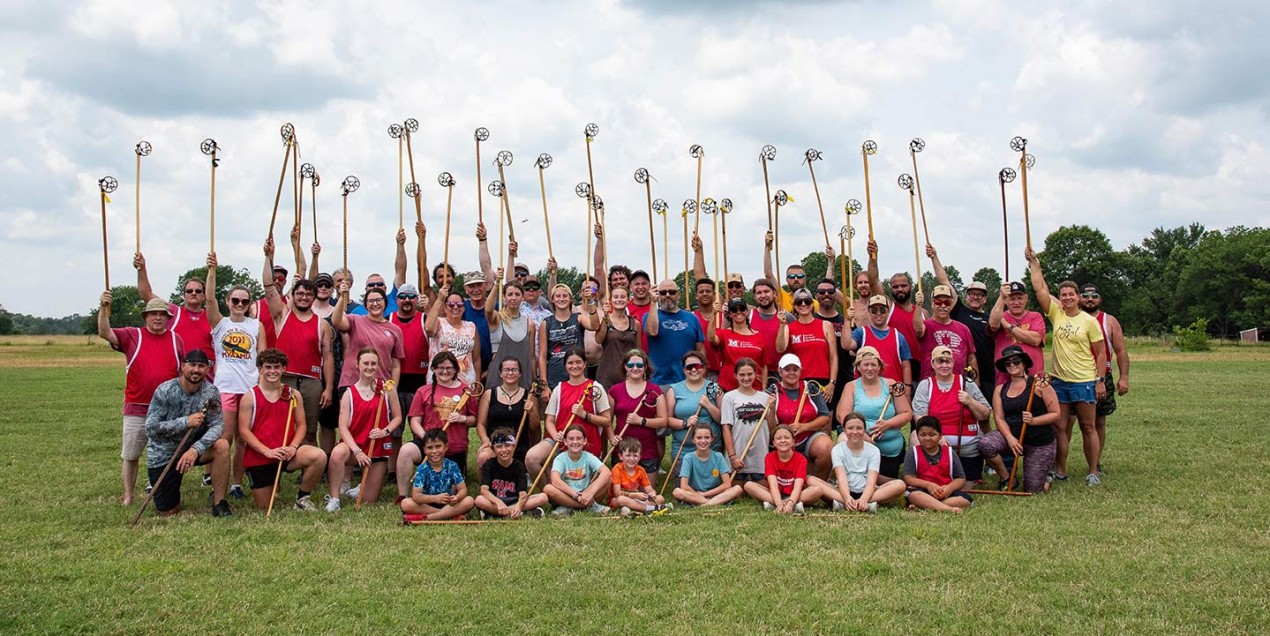Each month, Get to Know… will feature two members of UT System Administration’s talented and diverse staff as they offer insights into their lives in and out of the office. Each new edition will be published here. This week we present a special Q&A with Nichole Prescott in celebration of Indigenous People's Day on Monday, Oct. 9.
Nichole Prescott
Assistant Vice Chancellor
for Academic Affairs
Office of Academic Affairs

Born in an Indian Hospital in Oklahoma, Nichole is a proud citizen of the Miami Tribe of Oklahoma (Myaamia). A first-generation college student, she earned her bachelor’s degree at UT Austin and two master’s degrees at Miami University and Stony Brook University, where she also earned her Ph.D. in history. She maintains a strong engagement with the broader Native American community, is a frequent presenter at academic conferences and has authored and co-authored articles in scholarly as well as popular Native American publications. She is a member of the National Congress of American Indians, National Indian Education Association, and Native American and Indigenous Studies Association.

Let’s start with your job. What are your primary responsibilities?
I am responsible for leading and supporting student success initiatives systemwide, with particular focus on the education pipeline. I am leading the following initiatives: ElevateTXed (focused on educator preparation); Finish@UT (online education exchange and degree completion); Developmental Education and Corequisite Capacity Building;
College and Institutional Readiness; and All-Texas Academic Team (community college transfer) to name just a few. I also support Dr. Rebecca Karoff, associate vice chancellor for Academic Affairs, in systemwide work on Transfer, Equitable Student Pathways (a Lumina-funded initiative), and her efforts to build capacity for student success work on campuses through the Student Success Guiding Coalition. I am also the de-facto point-person for all things Indigenous. And I would love to take this opportunity to shout out to my amazing team who help make this work successful: Weston Rose, Ashley Reyes, Jeremy Martin, Jen Griffis, and Chris Lyons! THANK YOU!
You are a citizen of the Miami Nation. Who are the Miami Indians and where did your family history originate and what were the circumstances that led them to settle in Oklahoma, where you were born?
Aya Ceeki eeweemaakiki. Neehweeta weenswiaani myaamiatawenki, Nichole weenswiaani aakalaahšimaataweenki. Niila myaamia eeyaakwaa misiaani, kati nahi-mihtohseenia.
Hello all my relatives! Neehweeta is my traditional name, which means “She Speaks.” Nichole is my English name. I am a proud citizen of the Myaamia or the Miami Nation of Oklahoma and I strive to live as a proper human. I descend from the great Myaamia akima/chief Pacanne as well as Takumwah, a prominent Myaamia leader, businesswoman, political advisor and cultural mediator. My lineage experienced two forced removals, before settling in northeastern Oklahoma, where I was born. My mother pitilihnoohkwa/Rainwoman, was a respected elder in the tribe before she walked on, spending the last 15 years of her life back in our removal homelands of Oklahoma.
The Myaamia, or “Downstream People,” first emerged as a distinct people along the banks of the kociihsasiipi (St. Joseph’s River near South Bend, Ind.). We call our homelands Myaamionki (the place of the Myaamia). Today, we consider Myaamionki as along the Wabash River in Indiana (our heartland), the Marais des Cygnes River in Kansas, and the Neosho River in Oklahoma, reflecting our history. Our history consists of two forced removals — one at gunpoint from our original homelands in the Great Lakes region to Kansas, and one born from squatters and “Bloody Kansas” fights around the time of the Civil War from Kansas into Northeastern Oklahoma where we are currently based. Land is inextricably bound to who we are as Miami people. As for so many other native peoples in the U.S., the history of our forced relocations is a painful memory, and the cultural scars of that removal are still felt. We are resilient people, however, and my tribal community, like many others, is experiencing a vibrant language and culture revitalization that shines a hopeful illumination on our future as Indian peoples.

What is the worldview of Native Americans and their approach to life?
I began by introducing myself in my language because language is a powerful connector to identity. Many, if not most, Indigenous communities were displaced at some point in their histories. The miles that separated us from our homelands likewise separated many of us from our languages, our cultures and our traditional spirituality. Yet, we are still here. We continue to maneuver through this world, using the lessons of our ancestors and our understanding of the natural world where possible; trying to manifest a world that honors and harmonizes with our cultural identity and values.
Natives represent more than 600 Tribal Nations, 175 languages and 574 federally recognized Tribes, so there is no monolithic Indigenous worldview. That said, you can find some commonalities among many Indigenous nations. For most Native peoples, our world is entirely interdependent among the two-legged (humans), Grandmother Earth, the four-legged (animals), the winged relatives, the trees and the water. In my introduction, I used the phrase “ceeki eeweemaakiki,” which means “all my relatives.” We use that phrase intentionally to mean all people/things are related. In fact, some Native peoples refer to trees and other entities that English speakers would refer to as “what,” as “who” (as in “who is that tree?” instead of “what is that tree?”). I love this. Viewing ourselves as related to everything encourages us to be good relatives — to treat each other and the world around us with respect and keep us striving toward balance between taking and giving.
In which ways do you embrace the rich traditions and beliefs of the Miami tribe in your own family?
As I mentioned, my mother was an elder in the tribe before she walked on. She was the driving force in our family propelling us toward our culture when other things (i.e., adolescence, college, etc.) tried to distract us from it. When I was growing up, I never heard my language spoken since the last fluent speaker of Myaamiataweenki died in the 1960s. Much of our culture was “sleeping,” as we call it, due to removals and Indian Boarding Schools. But our tribe was still a political and social entity. Many tribal families were rooted (now) in Miami, Oklahoma (named after our tribe) and they still kept up kinship networks and relationships with other tribal communities.
These tribal relationships served to create a larger Indigenous community that got together for powwows, stomp dances and ceremonial dances. I grew up going to the powwows in the area. When I graduated from college in the 1990s, our tribe had just received a grant to build a language revitalization program. I was among the first cohorts to begin to study the language. Fast forward to 2001, the Myaamia Center was born through a tribally driven partnership with Miami University (named after my Tribe and situated on our historic homelands). The Myaamia Center is the research hub for all things Myaamia history, language and culture.
In my family, we use all of the various resources they have created such as dictionaries, phrase books, lunar calendars, earth and sky curriculum from a Myaamia perspective, and the published traditional stories in both English and the Myaamia language. We also attend our Tribal Annual Gathering every June where we play lacrosse with traditional sticks, throw tomahawks, compete in archery, as well as attend our general council meeting, followed by a community dinner and a powwow. In winter, we head back to Miami, Okla., for our Winter Gathering where we listen to our winter stories, which can only be told after the “the killing frost” in late fall and ends when the “thunder beings” arrive, i.e., when the frogs wake up and begin to croak in the spring. Winter Gathering is always followed by a stomp dance. These are just a few of the ways in which my family continues to practice our culture with our community. And, as I mentioned earlier, I do everything I can to live out my Myaamia worldview in how I treat others and how I treat Grandmother Earth.

